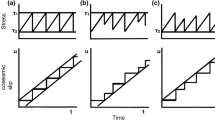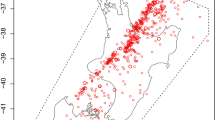Abstract
Stochastic earthquake models are often based on a marked point process approach as for instance presented in Vere-Jones (Int. J. Forecast., 11:503–538, 1995). This gives a fine resolution both in space and time making it possible to represent each earthquake. However, it is not obvious that this approach is advantageous when aiming at earthquake predictions. In the present paper we take a coarse point of view considering grid cells of 0.5 × 0.5°, or about 50 × 50 km, and time periods of 4 months, which seems suitable for predictions. More specifically, we will discuss different alternatives of a Bayesian hierarchical space–time model in the spirit of Wikle et al. (Environ. Ecol. Stat., 5:117–154, 1998). For each time period the observations are the magnitudes of the largest observed earthquake within each grid cell. As data we apply parts of an earthquake catalogue provided by The Northern California Earthquake Data Center where we limit ourselves to the area 32–37° N, 115–120° W for the time period January 1981 through December 1999 containing the Landers and Hector Mine earthquakes of magnitudes, respectively, 7.3 and 7.1 on the Richter scale. Based on space-time model alternatives one step earthquake predictions for the time periods containing these two events for all grid cells are arrived at. The model alternatives are implemented within an MCMC framework in Matlab. The model alternative that gives the overall best predictions based on a standard loss is claimed to give new knowledge on the spatial and time related dependencies between earthquakes. Also considering a specially designed loss using spatially averages of the 90th percentiles of the predicted values distribution of each cell it is clear that the best model predicts the high risk areas rather well. By using these percentiles we believe that one has a valuable tool for defining high and low risk areas in a region in short term predictions.
Similar content being viewed by others
References
D. Allcroft, and C. Glasbey, “Spatial disaggregation of rainfall using a latent Gaussian Markov random field.” In Proc. of the 17th International Workshop on Statistical Modelling, pp. 85–93, 2002.
J. Besag, P. Green, D. Higdon, and K. Mengersen, “Bayesian computation and statistic systems (with discussion),” Statistical Science vol. 10 pp. 3–66, 1995.
J. Besag, and C. Kooperberg, “On conditional and intrinsic autoregression,” Biometrika vol. 82 pp. 733–746, 1995.
N. A. C. Cressie, Statistics for Spatial Data, 2nd edition, Wiley: New York, 1993.
R. J. Geller, D. Jackson, Y. Y. Kagan, and F. Mulargia, “Earthquakes cannot be predicted,” Science vol. 275 pp. 1616–1617, 1997.
C. A. Glasbey, I. M. Nevison, and A. G. M. Hunter, “Parameter estimators for Gaussian models with censored time series and spatio-temporal data.” In R. Payne, and P. Green (eds.), COMPSTAT98 Proceedings in Computational Statistics, pp. 323–328, Physica Verlag: Heidelberg, 1998.
C. A. Glasbey, and I. M. Nevison, “Rainfall modelling using a latent Gaussian variable.” In T. G. Gregoire, D. R. Brillinger, P. J. Diggle, E. Russek-Cohen, W. G. Warren, and R. D. Wolfinger (eds.), Modelling Longitudinal and Spatially Correlated Data: Methods, Applications, and Future Directions, Lecture Notes in Statistics, vol. 122 pp. 233–242, Springer: New York, 1998.
L. Holden, B. Natvig, S. Sannan, P. Abrahamsen, and H. Bungum, “Modelling spatial and temporal dependencies between earthquakes.” In W. J. Kleingeld, and D. G. Krige (eds.), GEOSTATS 2000, Proceedings of the Sixth International Geostatistics Congress held in Cape Town, South Africa in April 2000, vol. 2 pp. 439–448, 2002.
Y. Ogata, “Space–time point process models for earthquake occurrences,” Annals of the Institute of Statistical Mathematics vol. 50 pp. 379–402, 1998.
Y. Ogata, K. Katsura, and M. Tanemura, “Modelling heterogeneous space–time occurrences of earthquakes and its residual analysis,” Applied Statistics vol. 52 Part 4 pp. 499–509, 2003.
E. J. Price, and D. T. Sandwell, “Small-scale deformations associated with the 1992 Landers, California, earthquake mapped by Synthetic Aperture Radar Interferometry Phase,” Journal of Geophysical Research–Solid Earth vol. 103 pp. 27001–27016, 1998.
F. P. Schoenberg, “Multidimensional residual analysis of point process models for earthquake occurrences,” Journal of the American Statistical Association vol. 98 pp. 789–795, 2003.
D. Vere-Jones, “Forecasting earthquakes and earthquake risk,” International Journal of Forecasting vol. 11 pp. 503–538, 1995.
M. West, and J. Harrison, Bayesian Forecasting and Dynamic Models, 2nd edn., Springer: Berlin Heidelberg New York, 1997.
C. K. Wikle, L. M. Berliner, and N. A. C. Cressie, “Hierarchical Bayesian space–time models,” Environmental and Ecological Statistics vol. 5, pp. 117–154, 1998.
C. K. Wikle, R. F. Milliff, D. Nychka, and L. M. Berliner, “Spatio-temporal hierarchical Bayesian modeling: tropical ocean surface winds,” Journal of the American Statistical Association vol. 96 pp. 382–397, 2001.
J. Zhuang, Y. Ogata, and D. Vere-Jones, “Stochastic declustering of space–time earthquake occurrences,” Journal of the American Statistical Association vol. 97 pp. 369–380, 2002.
Author information
Authors and Affiliations
Corresponding author
Rights and permissions
About this article
Cite this article
Natvig, B., Tvete, I.F. Bayesian Hierarchical Space–time Modeling of Earthquake Data. Methodol Comput Appl Probab 9, 89–114 (2007). https://doi.org/10.1007/s11009-006-9008-0
Received:
Accepted:
Published:
Issue Date:
DOI: https://doi.org/10.1007/s11009-006-9008-0
Keywords
- dynamical systems
- geostatistics
- Gibbs sampling
- MCMC
- model comparison
- seismology
- space–time modeling
- Bayesian hierarchical modeling




